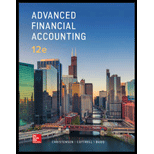
Concept explainers
a
Introduction: Accounting for business combination uses two methods, the purchase method and the pooling of interests method, but now all business combinations must use the acquisition method, many companies financial statements will continue to include the effects of previous business combinations.
Requirement 1
The number of outstanding shares did S have on its $5 par value shares.
a
Answer to Problem 1.39P
14,000 shares
Explanation of Solution
Book value of common stock held by S $70,000
Par value of shares $5
Number of shares at par value $5:
b.
Introduction: Accounting for business combination uses two methods, the purchase method and the pooling of interests method, but now all business combinations must use the acquisition method, many companies financial statements will continue to include the effects of previous business combinations.
Requirement 2
The price per share received at the time of issue, assuming that all share were issued.
b.
Answer to Problem 1.39P
Price per share $8.00
Explanation of Solution
Given Common stock value $70,000
Additional paid in capital $42,000
Number of shares 14,000 shares
c.
Introduction: Accounting for business combination uses two methods, the purchase method and the pooling of interests method, but now all business combinations must use the acquisition method, many companies financial statements will continue to include the effects of previous business combinations.
Requirement 3
The number of shares P issued at the date of combination
c.
Answer to Problem 1.39P
Number of shares issued at the date of combination 7,000 shares
Explanation of Solution
Given value of common stock of combined entity $117,000
Common stocks of P before combination $96,000
d.
Introduction: Accounting for business combination uses two methods, the purchase method and the pooling of interests method, but now all business combinations must use the acquisition method, many companies financial statements will continue to include the effects of previous business combinations.
Requirement 4
The amount of cash did P pay as stock issue.
d.
Answer to Problem 1.39P
The amount of cash P paid $24,000.
Explanation of Solution
Given
P’s cash balance $65,000
S’s cash balance $15,000
Combined cash balance $56,000
e.
Introduction: Accounting for business combination uses two methods, the purchase method and the pooling of interests method, but now all business combinations must use the acquisition method, many companies financial statements will continue to include the effects of previous business combinations.
Requirement 5
The market value of P’s shares issued at the date of combination
e.
Answer to Problem 1.39P
Market value of P’s shares $364,000.
Explanation of Solution
Given
Cash paid by P $24,000
Stockholders’ equity of combined entity: common stock $117,000, Additional paid in capital $553,000
f.
Introduction: Accounting for business combination uses two methods, the purchase method and the pooling of interests method, but now all business combinations must use the acquisition method, many companies financial statements will continue to include the effects of previous business combinations.
Requirement 6
The fair value of S’s inventory at the date of combination
f.
Answer to Problem 1.39P
The fair value of S’s inventory $110,000
Explanation of Solution
Given inventory of P before combination $210,000
Inventory of combined entity $320,000
g.
Introduction: Accounting for business combination uses two methods, the purchase method and the pooling of interests method, but now all business combinations must use the acquisition method, many companies financial statements will continue to include the effects of previous business combinations.
Requirement 7
The fair value of S’s net assets at the date of combination
g.
Answer to Problem 1.39P
The fair value of S’s net assets $306,000.
Explanation of Solution
Given:
Fair value of assets: Cash $15,000, Accounts receivable $30,000, Inventory $110,000, Building and equipment $293,000. Accounts payable $22,000, Bonds payable $120,000
h
Introduction: Accounting for business combination uses two methods, the purchase method and the pooling of interests method, but now all business combinations must use the acquisition method, many companies financial statements will continue to include the effects of previous business combinations.
Requirement 8
The amount of
h
Answer to Problem 1.39P
The amount of goodwill $58,000
Explanation of Solution
Market value of shares $364,000
Want to see more full solutions like this?
Chapter 1 Solutions
Advanced Financial Accounting
- Daniel acquires a 30% interest in the PPZ Partnership from Paolo, an existing partner for $39,000 of cash. The PPZ Partnership includes $10,000 of recourse liabilities. What is Daniel's basis in his partnership interest?arrow_forwardWhat is the gross profit for the period?arrow_forwardMCQarrow_forward

 AccountingAccountingISBN:9781337272094Author:WARREN, Carl S., Reeve, James M., Duchac, Jonathan E.Publisher:Cengage Learning,
AccountingAccountingISBN:9781337272094Author:WARREN, Carl S., Reeve, James M., Duchac, Jonathan E.Publisher:Cengage Learning, Accounting Information SystemsAccountingISBN:9781337619202Author:Hall, James A.Publisher:Cengage Learning,
Accounting Information SystemsAccountingISBN:9781337619202Author:Hall, James A.Publisher:Cengage Learning, Horngren's Cost Accounting: A Managerial Emphasis...AccountingISBN:9780134475585Author:Srikant M. Datar, Madhav V. RajanPublisher:PEARSON
Horngren's Cost Accounting: A Managerial Emphasis...AccountingISBN:9780134475585Author:Srikant M. Datar, Madhav V. RajanPublisher:PEARSON Intermediate AccountingAccountingISBN:9781259722660Author:J. David Spiceland, Mark W. Nelson, Wayne M ThomasPublisher:McGraw-Hill Education
Intermediate AccountingAccountingISBN:9781259722660Author:J. David Spiceland, Mark W. Nelson, Wayne M ThomasPublisher:McGraw-Hill Education Financial and Managerial AccountingAccountingISBN:9781259726705Author:John J Wild, Ken W. Shaw, Barbara Chiappetta Fundamental Accounting PrinciplesPublisher:McGraw-Hill Education
Financial and Managerial AccountingAccountingISBN:9781259726705Author:John J Wild, Ken W. Shaw, Barbara Chiappetta Fundamental Accounting PrinciplesPublisher:McGraw-Hill Education





